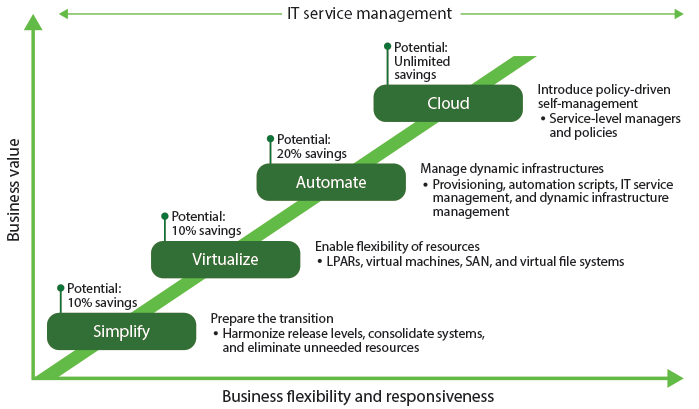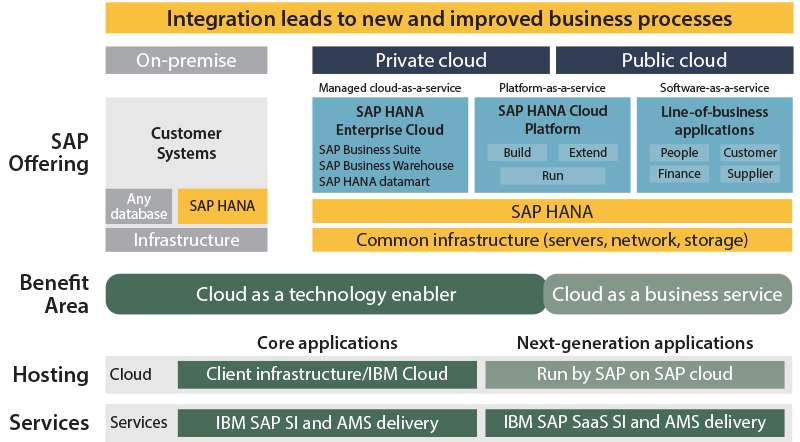Becoming a Digital Enterprise Starts with Cloud
Align Business and IT Objectives to Embark on a Transformation Journey
An uncomfortable truth for many companies is that IT organizations are becoming too slow to respond to the needs of the business. There is growing discontent as companies realize that complex on-premise systems are not responsive enough for a business to compete in a fast-paced economy that values customization, improved customer service, and immediacy in a robust, integrated network of partners, customers, and vendors. Complicating matters is an explosion of structured and unstructured data coming into the enterprise and the need for companies to immediately turn this information into actionable intelligence.
A growth in transactional data through mergers,acquisitions, or even new business models is only part of it; a surge of sensor data is driving the fervor for Internet of Things (IoT) and 4th Industrial Revolution technologies and solutions, and the rise of mobility as a preferred consumption model requires that data has to be available at any time, on any device.
Considering that close to 75% of the world’s transaction revenue touches an SAP system,1 the challenges outlined above should be easily recognizable for SAP customers, many of which have developed core, mission-critical systems in an on-premise environment over the past few decades. Many of these customers are considering how best to achieve the needed responsiveness with which they can deliver increased agility and flexibility, drive innovation, and lower costs.
Outlining a strategy to answer these difficult questions and embark on a journey to become a 21st-century agile enterprise is known as a digital reinvention. Increasingly, this entails transitioning on-premise legacy IT systems into a hybrid cloud environment. While some companies are initially reluctant to leave homegrown customizations behind, this reluctance quickly fades when taking a business process or use case to the cloud is shown to yield results otherwise impossible in a complex on-premise landscape.
Begin to Think Digitally
To take the first step in a digital reinvention journey, companies must align business objectives with an overarching IT strategy to determine the best way to establish and expand their digital footprint (see the “4-Step Roadmap for IT Optimization” sidebar on the next page). This requires a complete reexamination of business processes and, in some cases, looking closely at long-standing business models to explore if there is potential for an “Uber-ization” upheaval of the industry. What sort of process improvements could be made with real-time insights? How could a business better serve its customers if social or sensor data was integrated with its supply chain? For product manufacturers, what changes can be wrought when a sensor is attached to the product?
Companies that undertake this exercise swiftly discover that cloud is an essential ingredient as the quickest and most cost-effective way to capture increasing data volumes and create business insights. This is true for several reasons:
- The cloud’s scalable model means that organizations can scale up or down on demand according to infrastructure needs, which is key to providing the responsiveness necessary to pivot in near real time to pressing business concerns.
- The cloud offers a rapid deployment to a technology refresh without having to invest in additional hardware, an important consideration for a quicker path to innovation.
- This financial flexibility allows companies to shift their budgets from capital to operating expenses, letting the business pay only for what is used and freeing up resources that can be reinvested in the business.
The journey toward becoming a digital enterprise most often incorporates a hybrid cloud strategy because it accomplishes the aforementioned objectives while also satisfying long-held requirements concerning system security, mission-critical availability, performance, and business continuity. A hybrid strategy strikes the right balance between honoring established business needs while still making the necessary adjustments to move the business forward for the digital age.
3-Pronged Journey
Typically, there are three types of movement toward a digital enterprise that together define a hybrid approach:
- The first is optimizing existing systems to make them cloud-ready; this means adopting certain standardizations in return for a flexible infrastructure that allows a company to extend its reach globally. This step satisfies the requirement for speed to deployment in a flexible platform for the digital age.
- Second, once existing systems are optimized, the question becomes how to enhance and integrate a new front-end user experience with these back-end core systems.
- The third movement is recognizing that integrating new software-as-a-service (SaaS) applications with back-end systems can also lead to innovation, as does leveraging a cloud platform to develop orextend existing applications.
The fact that 90% of the data in the world has been created in the last two years2 makes it very difficult for organizations to embark on a digital journey without outsourcing either some or all infrastructure to managed services. IT departments that are already stretched thin simply do not have the resources to provision and manage a new cloud infrastructure that allows a business to change processes on the fly. This is especially true if that cloud infrastructure includes moving to new technology. For the SAP customer, this often means a migration to SAP S/4HANA.
This drives at the strength of the collaboration between IBM and SAP in helping the SAP customer with a digital reinvention, as both companies share a vision for what it means to become a truly digital enterprise. SAP and IBM are both firmly established as leading cloud companies, with SAP positioning itself as a leader in in-memory database technology and architecture, specifically with SAP HANA and SAP S/4HANA, and IBM positioning itself as a leader in cognitive solutions.
The significant investments that both companies have made in extending cloud capabilities complement what each company has brought to market. IBM has made major investments in its cloud platform that has enabled it to be named as a top performer and leader in the private and hybrid cloud market by Synergy Research.3 For SAP, investments include coalescing its cloud strategy around SAP S/4HANA and making evolutions to this next-generation business suite.
Together, these capabilities help guide a customer along that path of three movements toward a complete digital reinvention.
A hybrid strategy strikes the right balance between honoring established business needs while still making the necessary adjustments to move the business forward for the digital age.
A Foundation for the Digital Core
With a move to SAP S/4HANA as the digital core of the enterprise and a strong driver for a cloud migration, companies capitalize on the benefits of both the cloud and the simplified SAP S/4HANA architecture that includes a complete rewrite of SAP ERP Central Component (SAP ECC) code phased by functional area and moving some application code to the database layer as stored database procedures. This new data model removes old tables, aggregates, and indices to fewer column-based tables, resulting in a single source of truth, real-time operational analytics, and integration to both IoT and business networks for real-time collaboration in the networked economy.
Many of these benefits can only be realized in the cloud, and IBM Cloud for SAP Applications helps optimize an SAP environment and ameliorate some of the common challenges associated with SAP cloud workloads, such as cost, complexity, performance, resiliency, and specialization (see the “End-to-End Cloud” sidebar on the next page). At a high level, these challenges are addressed by the following:
- Using economies of scale helps improve cost efficiency.
- Automation and standardization ease complexity.
- An enterprise-class infrastructure helps manage performance requirements.
- A cloud-enabled infrastructure backed by service-level agreements (SLAs) addresses resiliency for core business processes.
- Teams of SAP specialists who average nearly a decade of experience with SAP solutions address specialization requirements.
A Gateway to Innovation: Industry Examples
However an organization chooses to optimize itsSAP cloud landscape with IBM, taking advantage of this collaboration between in-memory and cognitive leaders will result in benefits that are restricted only by imagination. In human resources, for example, companies are using IBM Kenexa Talent Insights, powered by IBM Watson, to improve business outcomes by starting to predict the impact of talent decisions. Because the solution can run talent analytics on any workforce data, potential to overhaul existing HR processes increases greatly when it is integrated with the in-memory capabilities of SAP HANA. This means that Kenexa customers who also run SAP solutions — SAP SuccessFactors solutions or SAP S/4HANA, for instance — can bring real-time capabilities into the picture with additional predictive tools that SAP HANA provides.
Healthcare provides another compelling use case. Hospitals are using IBM Watson Health, IoT technology, and advanced analytics to explore new ways of learning about and treating disease. For a hospital that is also using an SAP solution as its enterprise system of record along with analytic capabilities embedded in SAP HANA, the possibilities of leveraging IBM Watson Health from the perspective of improved business processes can be endless.
One joint IBM and SAP customer in the airline industry is leveraging cognitive and in-memory computing to significantly improve its maintenance, repair, and overhaul (MRO) processes. At first glance, this might not seem to be a high-value target for a digital enterprise, but more efficient MRO processes lead to a significant reduction in airline turnaround time, which in turn leads to fewer delays, greater cost savings, and, ultimately, more satisfied customers. With an estimated $10,000 financial hit for every hour of lost airtime, airlines must adhere to a tight schedule without sacrificing rigorous and exhaustive pre- and post-flight checks. Using IoT, in-memory, and cognitive solutions to predict when a part might fail and proactively make a change, for example, can significantly improve MRO processes and help ensure more on-time departures. Tighter control over inventory can impact any number of downstream processes, from warehouse and transportation management to procurement. Even though MRO is a very mature process, this example demonstrates how much of a difference can be made by adding a fairly straightforward digital innovation.
The opportunity to make this kind of transformation exists in all industry verticals and for any size enterprise. Increasingly, customers realize that the business use cases or innovations they are trying to implement are difficult, if not impossible, to achieve without transitioning to the cloud. One joint customer decided to grow the business through acquisition and realized that its existing systems could not sustain the projected growth. Its path toward becoming a digital enterprise meant using IBM Cloud for SAP Applications to manage its SAP HANA Enterprise Cloud deployment, where it sacrificed some customization as a trade-off for application standardization that it saw as necessary to improve its business processes on a global scale. Another customer turned to SAP HANA Enterprise Cloud because it wanted to implement advanced analytics solutions running with SAP HANA, and a hybrid parallel cloud system provided it with the capability to agilely extract the necessary data from its on-premise systems without sacrificing performance.
Consumer expectations for personalization and immediacy are changing delivery models of products and services, and undertaking a digital reinvention of the enterprise is the most surefire way to ensure that a business isn’t left behind.
A New Era, a New Wave
Looking more closely at SAP S/4HANA as the centerpiece of the digital core, an analogy can be made that this transformative technology is taking the SAP customer on a similar — if accelerated — path to the one SAP R/3 paved upon its release in the early 1990s. At that time, SAP was at the forefront of innovation, dealing with the move away from the mainframe to client-server open systems and packaged application software — and system integrators and implementation partners were riding the wave of reengineering. Today, the wave of innovation centers around real-time, in-memory, and cognitive, all built on a simplified system architecture and state-of-the-art hybrid IT platform. Then, as now, SAP is the enabler of this transformation, and IBM’s SAP resources are focused accordingly to help ensure that from an implementation, infrastructure, and migration standpoint, customers can make a digital transformation with minimal disruption.
Just as business reengineering evolved with the phasing out of mainframe computing in favor of client-server systems, so too is the digital imperative emerging as cloud, mobile, in-memory, and simplified system architecture combine to provide the enterprise with a means to rapidly adapt to a digital economy. Consumer expectations for personalization and immediacy are changing delivery models of products and services, and undertaking a digital reinvention of the enterprise is the most surefire way to ensure that a business isn’t left behind.
As a next step, organizations can access the IBM Cloud Managed Services Benefits Estimator at https://roianalyst.alinean.com/ibm_bva/AutoLogin.do?d=616569597576534238 to analyze potential benefits and outcomes of working with IBM to move to the cloud.
1 See bit.ly/corporatefacts. [back]
2 See www-01.ibm.com/software/data/bigdata/what-is-big-data.html. [back]
3 See www-03.ibm.com/press/us/en/pressrelease/48829.wss. [back]













